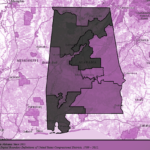This is the fourth article of a 10 part series on redistricting + apportionment + gerrymandering, in relation to Alabama.
If you have been reading these posts in order (and have just read in part 3 about how Alabama has a permanent committee of the legislature to deal with this), you may be thinking that we’re all set. Here’s the problem that you may not be aware of: in 2018, 43% (about 3 in 7) of Alabamians voted to have a Democratic representative in Congress. A little less than 4 in 7 (55%) voted for a Republican Congressperson. From this perspective, Alabama doesn’t seem as partisan (or dominated by one party) as we are often led to believe. If we just think about the numbers in terms of statewide voter preferences, if we have 7 Congressional districts, then 3 of them should have sent a Democrat to Congress, and 4 of them should have sent a Republican. But what do we actually have? Only 1 in 7 (14%) was won by a Democrat. Does this seem fair to you in terms of actual representation of citizens by elected officials?
So now you may be thinking: How in the world can this happen? The answer is the infamous “gerrymandering,” a political manipulation by which district boundaries are drawn to create the kind of unfair effect that we see in Alabama. We’ll go into the “art” of gerrymandering in the next post. Here we will look at what the League of Women Voters recommends, and then examine an alternative in another state.
The U. S. Constitution says that the Congressional districts shall be determined by elected branches of government, and this means the legislatures in each state. Alabama has the Permanent Committee on Reapportionment, discussed in the previous post (#3), that currently is composed of 6 Democrats and 15 Republicans.
The position of the League of Women Voters on redistricting is that “The League of Women Voters believes responsibility for redistricting preferably should be vested in an independent special commission, with membership that reflects the diversity of the unit of government, including citizens at large, representatives of public interest groups, and members of minority groups.” This would, in principle, eliminate the possibility that the new redistricting maps would be drawn to create partisan advantage.
The current League standards on which a redistricting plan is based, and on which any plan should be judged, must:
- Be enforceable in court;
- Require:
- Substantially equal population,
- Geographic contiguity, and
- Effective representation of racial and linguistic minorities.
- Provide for (to the extent possible):
- Promotion of partisan fairness,
- Preservation and protection of “communities of interest,” and
- Respect for boundaries of municipalities and counties.
- Compactness and competitiveness may also be considered as criteria so long as they do not conflict with the above criteria
- Explicitly reject:
- Protection of incumbents, through such devices as considering an incumbent’s
- address; and
- Preferential treatment for a political party, through such devices as considering party affiliation, voting history and candidate residence.
An interesting contrast with Alabama is California, which established the California Citizens Redistricting Commission by the citizen initiative process (which is not available under the Alabama Constitution). It draws both federal Congressional districts and state legislative districts. It has the following partisan breakdown: five members registered with the largest political party in California based on registration (in 2011, Democrats); five members registered with the second-largest political party in California based on registration (in 2011, Republicans); four members who are not registered with either of the two largest political parties in California based on registration. A supermajority vote is required for the commission to approve district maps, with at least three affirmative votes from each group of political party affiliates—Democrats, Republicans and those unaffiliated with either party. It uses the following criteria in drawing the districts: compactness, contiguity, preservation of political subdivisions, communities of interest, prohibition on favoring or disfavoring an incumbent or candidate, prohibition on using partisan data. According to the National Conference of State Legislatures, “in the 2010 cycle, the commission’s districts withstood all legal challenges.” This report from the Public Policy Institute of California assesses the effects of the commission on partisan fairness and competitiveness.
Read more about redistricting systems in all 50 states on the National Conference of State Legislatures website.
This series is a joint effort of the blog editor, Catherine Davies, and other members of the Advocacy Team and Board of the League of Women Voters of Alabama.

